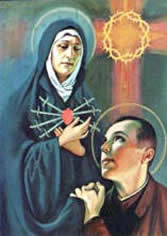On the first of March in 1838, in the little town of Assisi, Italy, a boy named Francis was born who, like the famous founder of the Franciscan order, would become a Saint. He was the eleventh of thirteen children and his mother died when he was four years old.
Francis (who later look the religious name Gabriel of Our Lady of Sorrows) had a “sweet, good-humored, persevering, settled and generous temperament, and also possessed a sensible heart full of affection…He was well-spoken, proper, intelligent, loving and full of a surprising grace…” (Fuentes, p. 24s)
He was very tall in stature (around 1.7 meters), and had “ a good voice, was agile and well-formed” (ibid).
With his family he was moved to Spoleto when, as the other Francis, he was a leader of the youth. In this place there was a school of the brothers of the Christian Schools, and attended a classical secondary school run by the Jesuits. He greatly enjoyed singing and achieved rewards in Latin poetry and in theatrical evenings. He was a dynamic youth, with a great passion for his Christian faith. In his house he had placed a statue of the Pieta for his personal veneration.
When he went to the Meliso theatre with his father, many times he would sneak away secretly in order to pray under the portico of the Cathedral, which was very near to there; he would return late before the conclusion of the function in order to leave with the other spectators. Some times he used a hair shirt and it is known that one time he turned down the dishonest propositions of a libertine who was threatening him with a pen-knife.
Intervention of the Blessed Virgin Mary
On August 22, 1856, while attending the procession of the “Holy Icon”, a Marian image venerated in Spoleto, the Virgin Mary spoke to his heart in order to in invite him with urgency, “You are not called to follow the ways of the world. What are you doing, then, in it? Enter the religious life” (Fuentes, p. 208). On September 10, 1856, he entered the Passionist novitiate in Morrovalle (Macerata) and took the religious name Gabriel. He was 18 years old. His surrender was with his whole heart, and the religious life made him happy: “The happiness and joy that I enjoy within these walls is unimaginable” (Writings, p. 185). His greatest loves were Jesus Crucified, the Eucharist and the Virgin Mary.

On August 22, 1856, while attending the procession of the “Holy Icon”, a Marian image venerated in Spoleto, the Virgin Mary spoke to his heart in order to in invite him with urgency, “You are not called to follow the ways of the world. What are you doing, then, in it? Enter the religious life” (Fuentes, p. 208). On September 10, 1856, he entered the Passionist novitiate in Morrovalle (Macerata) and took the religious name Gabriel. He was 18 years old. His surrender was with his whole heart, and the religious life made him happy: “The happiness and joy that I enjoy within these walls is unimaginable” (Writings, p. 185). His greatest loves were Jesus Crucified, the Eucharist and the Virgin Mary.
Death
In the convent of Isola when the first rays of sun were entering his cell on the morning of February 27, 1862, Gabriel was consumed in an ecstasy of love and surrounded by the religious that were crying by his bed, he abandoned the earth and went to heaven, invited by the Virgin Mary.
In the convent of Isola when the first rays of sun were entering his cell on the morning of February 27, 1862, Gabriel was consumed in an ecstasy of love and surrounded by the religious that were crying by his bed, he abandoned the earth and went to heaven, invited by the Virgin Mary.
Thirty years later, on October 17, 1892, the process was begun to recognise him as a Saint, as there was already a devotion to him among the faithful and many miracles had occurred.
He was canonised in 1920 by Pope Benedict XV.
Declared a co-patron of the Catholic youth of Italy in 1926, and the principal patron of Abruzo in 1959.
Saint Gemma Golgani, upon reading the life of Saint Gabriel of Our Lady of Sorrows, felt a strong spiritual tie with him and he appeared to her on many occasions in order to guide her and console her.
No comments:
Post a Comment
Comments are subject to deletion if they are not germane. I have no problem with a bit of colourful language, but blasphemy or depraved profanity will not be allowed. Attacks on the Catholic Faith will not be tolerated. Comments will be deleted that are republican (Yanks! Note the lower case 'r'!), attacks on the legitimacy of Pope Leo XIV as the Vicar of Christ, the legitimacy of the House of Windsor or of the claims of the Elder Line of the House of France, or attacks on the legitimacy of any of the currently ruling Houses of Europe.